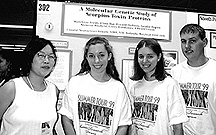
| T H E N I H C A T A L Y S T | S E P T E M B E R – O C T O B E R 1999 |
|
|
|
BOUNTY OF SUMMER STUDENTSON DISPLAY AT POSTER DAY |
text and photos
|
 |
|
The
Gang of Four:
(left to right) Elisa Hui, Natalie Regier, Madeleine Fersh, and Ronald
Redmon present "A Molecular Genetic Study of Scorpion Toxin Proteins."
|
The rest of Maryland may have been enduring the worst drought in memory, but, judging from the bumper crop of energetic young scientists at this year’s Poster Day, conditions at NIH this summer were perfect for raising future clinical researchers. Here is a random sampling of the research of this season’s summer students.
A highly charged foursome from the NIMH laboratory of Ed Ginns and Brian Martin jointly produced and enthusiastically discussed their poster on scorpion toxin proteins. The collegiate member of the crew was Madeleine Fersh, a neuroscience major entering her senior year at the University of Pennsylvania in Philadelphia. Joining her on the molecular genetic study of scorpion venom were three Maryland high school students on the threshold of their senior year: Elisa Hui, of Gaithersburg High School, Ronald Redmon, of Gwynn Park High School in Brandywine, and Natalie Regier, of Bethesda–Chevy Chase High School in Bethesda. Working under Suzanne Winfield, the students helped identify novel bioactive components, including two active ingredients from the venom of Tityus serrulatus: hemolysin and a protein that appears to be a potassium channel blocker. All four aspire to medical school and to more research at NIH.
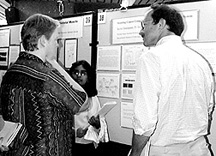 |
|
Vectorious:
Savita
Dandapani (center) attends with interest as two viewers discuss her research
on "Modeling Cancer Using an Avian Retroviral Gene Delivery System."
|
Someone down the hall from the lab of Savita Dandapani’s mentor at the Massachusetts Institute of Technology in Cambridge had worked with Harold Varmus and gave his lab a favorable review, so the MIT senior was urged to write the NIH director to see if a summer spot
might be available. That was the start of a productive two months. Supervised by NCI-DBS’ Yi Li in the Varmus lab, Dandapani worked on developing a mouse model of breast cancer, using a retrovirus from chickens to ferry the c-myc oncogene quite specifically into mouse mammary tissue. Following an approach developed by the Varmus lab, initially in collaboration with Steve Hughes and Mark Fetterspiel at NCI-FCRDC, the lab created a vector bearing the gag, pol, and env genes from the avian retrovirus, then added marker genes and the oncogene of interest—in Dandapani’s work, this was a tagged myc or the gene for RCAS-luciferase. Normally, Dandapani notes, mammalian cells would not be a functional host for an avian virus, but the mice and mammary cells she worked with had a tissue-specific promoter linked to the avian virus receptor, allowing the virus to infect mammalian cells.
Ticking off the advantages of the avian viral vector over murine viruses, such as the Maloney virus, Dandapani points to high-titer efficiency in the transfer of genes and the tissue-specific targeting made possible by the tissue-specific transgene encoding the viral receptor. But perhaps the biggest advantage of the avian viral vector, as demonstrated by Eric Holland in his brain tumor model that used the chicken virus, is that it cannot crank out immunogenic proteins or replicate in a mammalian cell.
Over the course of the summer, Dandapani and her mentor were able to show that they could use the chicken virus system to insert the myc oncogene into mammary cells of the mouse, in vitro and also in vivo through intraperitoneal injection. As she wraps up her summer project, Dandapani will be testing other injection methods to maximize gene transfer. It will be up to the folks who remain in Bethesda after school resumes to follow the mice and see if they develop tumors. "This was exciting," she says, "and I learned a lot about retroviruses." Dandapani, who has previously done gene knockout research with her advisor at MIT, hopes to start an M.D. or M.D.-Ph.D. program that will allow her to combine research with clinical work after she graduates.
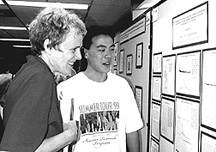 |
|
Positively
Tubulin:
Raymond Liu (right) shows Cherie
Fisk, ORS, an "Analysis of the Post-Translational Modifications
of Laser-Captured Tubulin Using Isoelectric Focusing and MALDI Time-of-Flight
Mass Spectrometry."
|
Raymond Liu was one of 12 college students in NIH’s new Biomedical Engineering Summer Internship Program supported by The Whitaker Foundation, the Foundation for the NIH, and NIH itself (see interview with Constance Battle and Ted Colburn). Liu will be a senior next year at the University of California, San Diego, and hopes to continue on to medical school to become a physician or clinical researcher. "I did stuff here that people haven’t done before, and that’s really cool," Liu raves. "And I got to work with great people." Liu worked with Dan Sackett, Robert Bonner, and Al Yergy in NICHD. The group is developing a two-step approach to analyze protein isotopes and post-translational modifications, in this case, tubulin. After using high-resolution isoelectric focusing to separate the different forms in sharp gel bands, Liu cut and transferred the focused band, isolated the minute amount of protein in it, and subjected it to mass spectroscopy—which revealed two distinct peaks, suggesting at least two forms of tubulin within the band.
 |
|
Only
the Beginning: Duewa
Williams’ research on "EEG Relating to HIV+ Cocaine Patients"
has instilled a desire in the high school senior to return to NIH.
|
Duewa Williams’ first summer at NIH has reinforced her fascination with science. "It’s a real advantage," she says, "to get this kind of research experience" early in one’s education. About to enter her senior year at Lakewood (N.J.) High School, Williams worked in the laboratory of NIDA’s Jean Cadet and Ronald Herning under preceptor Kimberly Tate and alongside another student, Nishant Tella. Her research project involved deciphering the combined and individual effects of drug abuse and HIV on the brainwave patterns of drug abusers. Williams says she hopes to return to NIH, perhaps to continue studying HIV.
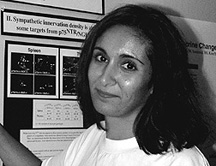 |
|
Footprints:
Yvette Sandoval presents an "Analysis of the Density of Sympathetic
Innervation of Target Tissues from Transgenic Mice with Altered p75 and
NGF (Nerve Growth Factor) Levels."
|
Yvette Sandoval, a senior at San Diego State, spent her first summer at NIH working with Christine Brennan in the laboratory of the NINDS scientific director, Story Landis. Sandoval was conducting research on the role of p75, one of two receptors for nerve growth factor, an essential neurotrophin for the growth and development of the sympathetic nervous system. She compared the numbers of sympathetic nerve endings in the thymus and spleen of p75-knockout and wild-type mice. Her data, combined with other data Brennan has published on foot-pad target tissues, have led the group deeper into mystery because they have concluded that p75 does not work either to cause apoptosis or to prevent it, as others have proposed. Sandoval, a cell and molecular biology major, hopes to return to NIH for a year as a postbac before going on to graduate school. "Christine Brennan," says Sandoval, "is a great mentor."
 |
|
On
Neuropsychiatry’s Threshold: Elizabeth
Thompson got a taste of neuropsychiatry and chocolate in the course of
her research on"Regional Cerebral Blood Flow Changes in Response
to Olfactory Stimuli in Alcoholic Patients and Normal Controls by [15-0]
PET."
|
Elizabeth Thompson has similar high praise for her more clinically oriented mentor, NIAAA’s Wendol Williams. Thompson, who is going into her second year at Howard University Medical School in Washington, D.C., compared responses to olfactory stimuli in alcoholics vs. control patients using PET brain imaging and the subjective reactions of the patients to pleasant, unpleasant, and alcohol-like odors. Differences in the PET scans were subtle, but Thompson’s hoping to see more marked differences between the groups in their subjective reactions, data that she was just beginning to sort out at the time of the Poster Day.
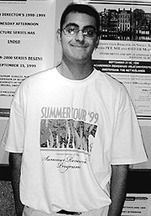 |
|
The
Party’s Not Over: Neil
Sanghui’s research on "Alteration in Gene Expression in Neuropsychiatric
Disease" may blossom into a career in clinical research and practice.
|
Although Thompson had not previously contemplated going into neuropsychiatry, she says she is now thinking about it. She says she especially enjoyed working with the patients. "I learned a lot about how to do research, about the diagnosis of patients," Thompson says. One patient sent her a box of Godiva chocolates to thank her for her help. "It’s good to know you make a difference," Thompson says. "I definitely hope to end up in clinical research because that is what is ultimately going to help the most. I love being on the frontier, testing hypotheses, seeing what works. Not everything is going to work out, but at least you know you tried."
The poster next to Thompson’s
was presented by Neil Sanghui. Sticking around until the bitter end of
the research fete, well after other students had taken down their posters, Sanghui
was enthusiastic about his research with NIMH mentor David
Jacobowitz and Francis
Lau. "This was a wonderful experience," Sanghui said. Now going
into his second year at the New Jersey Medical School in Newark, Sanghui says
he jumped on the lab’s major effort in applying differential display technology
to identify altered expression of genes in the brains of people who have died
with schizophrenia or bipolar disorder. The work this summer revealed that OXA1,
a gene homologous to the mitochondrial oxidase assembly protein, is upregulated
in postmortem brains from schizophrenics, compared with brains of age-matched
people who did not have the disorder. Sanghui says the summer piqued his interest
in clinical research and in some day incorporating it into a clinical practice.
![]()